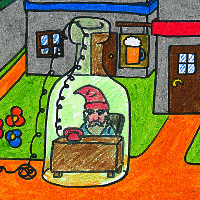 The Book of Living Magic, by Jonas Kyratzes, is the latest in a series of excellent, idiosyncratic works by a relatively unsung developer. This one is a followup to his Desert Bridge (one of my favorites), and it’s got the same sort of funny, childlike but not childish feel. The crayon drawings are appropriate to the gently subversive ideas being presented, and it’s simply packed with extraneous examinable items. In one late-game scene, every book on a bookshelf is clickable. They’re all clearly irrelevant, but if you want you can find out the clever title of each.
The Book of Living Magic, by Jonas Kyratzes, is the latest in a series of excellent, idiosyncratic works by a relatively unsung developer. This one is a followup to his Desert Bridge (one of my favorites), and it’s got the same sort of funny, childlike but not childish feel. The crayon drawings are appropriate to the gently subversive ideas being presented, and it’s simply packed with extraneous examinable items. In one late-game scene, every book on a bookshelf is clickable. They’re all clearly irrelevant, but if you want you can find out the clever title of each.
One of the interesting aspects of this game is that it’s really not about the story. Most of Kyratzes’s games are heavily storied; either you’re participating in or uncovering story (usually both). In this, however, you’re just exploring the world. The puzzles are simple and rather oddball, and your player character doesn’t make her personality very known. Instead, you’re meeting strange creatures (like Provatica the Unhefted, sheep adventurer) and visiting strange locales (like the Forest of Eyeballs). As one of Kyratzes’s games set in the Land of Dream, everything is appropriately surreal and dreamlike.
There are bits of darkness that pop out, though. Something happened to change Raven Locks Smith’s parents from dreamers to boring people, and it must be related to Mr. Urizen, Mayor of Dull, a recurring entity in Kyratzes’s works. A robot you meet is on the run from a government determined to turn him into a soldier. And the countryside around the town of Oddness Standing clearly has a long and often-solemn history that’s only hinted at in the game.
Play it. It’s short, it’s funny in a way that few games are, and it comes from the heart.
I played this and loved it to bits. My overwhelming impression was of absolute sincerity and love, and the desire to communicate that to the player.
Also, my hat goes off to you for pointing out that, while there isn’t much puzzling or violence, the focus of the work is not the story but the *world*. Too often gamers simply use “story” as a catch-all term for anything not immediately manipulable. Hundreds of years of literary theory says differently.
Also, there’s a reason why Mr. Urizen is such a threatening, shadowy figure:
http://en.wikipedia.org/wiki/Urizen
Urizen was a mythical figure created by William Blake, and is Blake’s vision of conventional reason and wisdom. (One of my lecturers even suggested there might be a pun in there: “Urizen” = “Your reason”?) Although I’ve not read Blake’s works, this lecturer pointed out that Blake essentially reimagined and refashioned Christian theology to reflect his own views, and that Urizen is actually a radical and terrifying reinterpretation of Satan.
It’s unclear that Kyratzes’s Urizen is the same as Blake’s Urizen. I don’t know the Blake version well, but he seems to be a friend of science and not inclined toward outright destruction despite his satanic status. In Desert Bridge, Urizen is a person/group that the super-scientist Bill considers quite threatening to his work, and if I recall correctly it destroys or at least attacks the City of Dreams. I wish I had a transcript of Desert Bridge to look things up in.
Oh wow, really? Sadly I never got to play Desert Bridge since it won’t work on my machine. I like the way Jonas seems to be constructing a sort of personal universe, taking some inspiration from Blake (if only as a starting point for character archetypes) but then making it his own.
I’m pleased to see these recent blog entries. There was a long dry spell there with only comics – I enjoy reading your reviews and analyses and thoughts and so forth.
So does that mean that you’re done with the comics?
Nope, they’re still in the queue.
Upon playing the game the second time (of course I would), I noticed that the girl is rather similar in appearance to pip-boy. I guess this opens up a few new means of interpretations, doesn’t it?